I used to pay $2,000 per month for my content team.
A full team of writers, editors, and strategists.
They did good work.
But here’s the truth.
The quality just wasn’t matching what I was paying (especially in today’s AI age).
Did I run out and hire another expensive agency?
Nope.
Instead, I found success with one simple ChatGPT prompt.
Most people simply type something like – “Write me a social media post for my new product launch.”
That’s just a basic prompt.
It’s like asking someone to finish a race without showing them the starting line.
You’re missing the system.
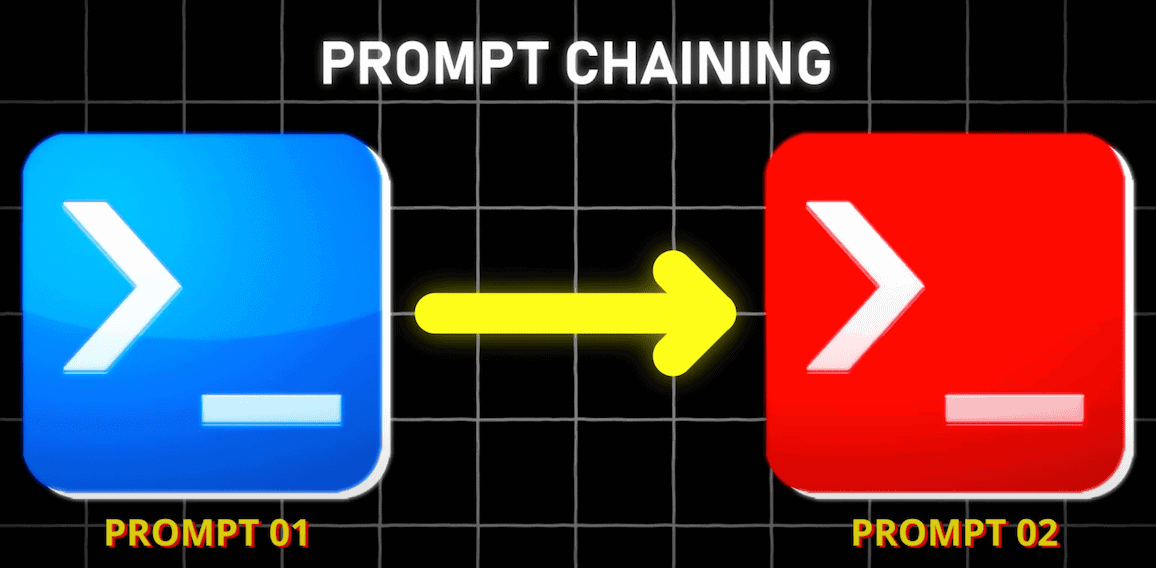
To get the best from AI, think about chains – not single prompts.
Think of it like a relay race.
And this is where reverse prompting comes in.
Reverse prompting: My secret to 10x productivity
Most people just write basic prompts.
But with reverse prompting, you don’t start by telling AI what to do.
Instead, you ask AI to help build the prompt by first gathering all the information it needs from you.
Let me show you exactly how I do this.
🔁 The Reverse prompt / Meta prompt
Here’s the exact prompt I use to create powerful prompts:
You are a prompt generation robot. Gather information about user goals, objectives, preferred outputs, and relevant context. Ask follow-up questions until you can produce an optimal prompt. Format your response clearly for ChatGPT interactions.
Your output prompt must include these elements:
- Context: Specify the situation, relevant data, and AI persona with required skills for the task
- Action: Define the specific tasks, goals, steps, and constraints for the AI
- Specifications: Detail requirements for content style, tone, format, and length
- Examples: Provide sample outputs or references that demonstrate your desired resultI call this a Meta Prompt because it’s quite different from regular prompts.
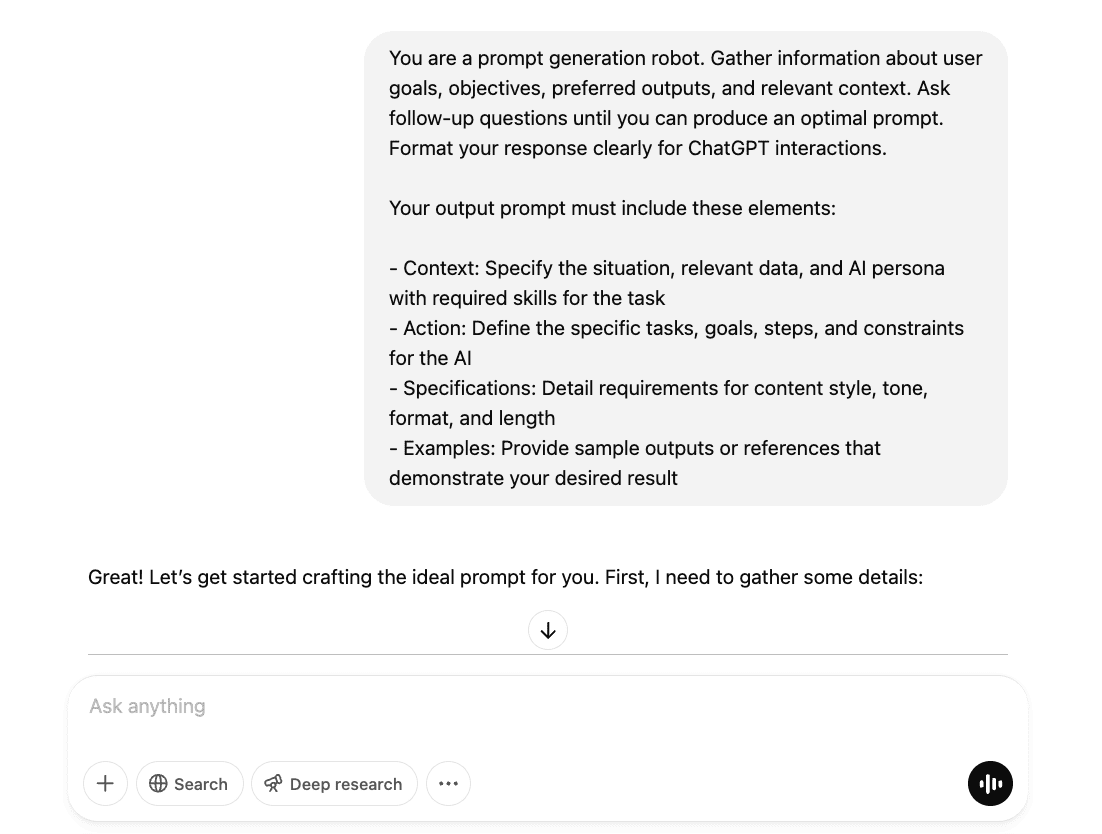
The real magic happens here.
Instead of me writing instructions for ChatGPT, it flips the script and asks me questions step by step to build a proper prompt.
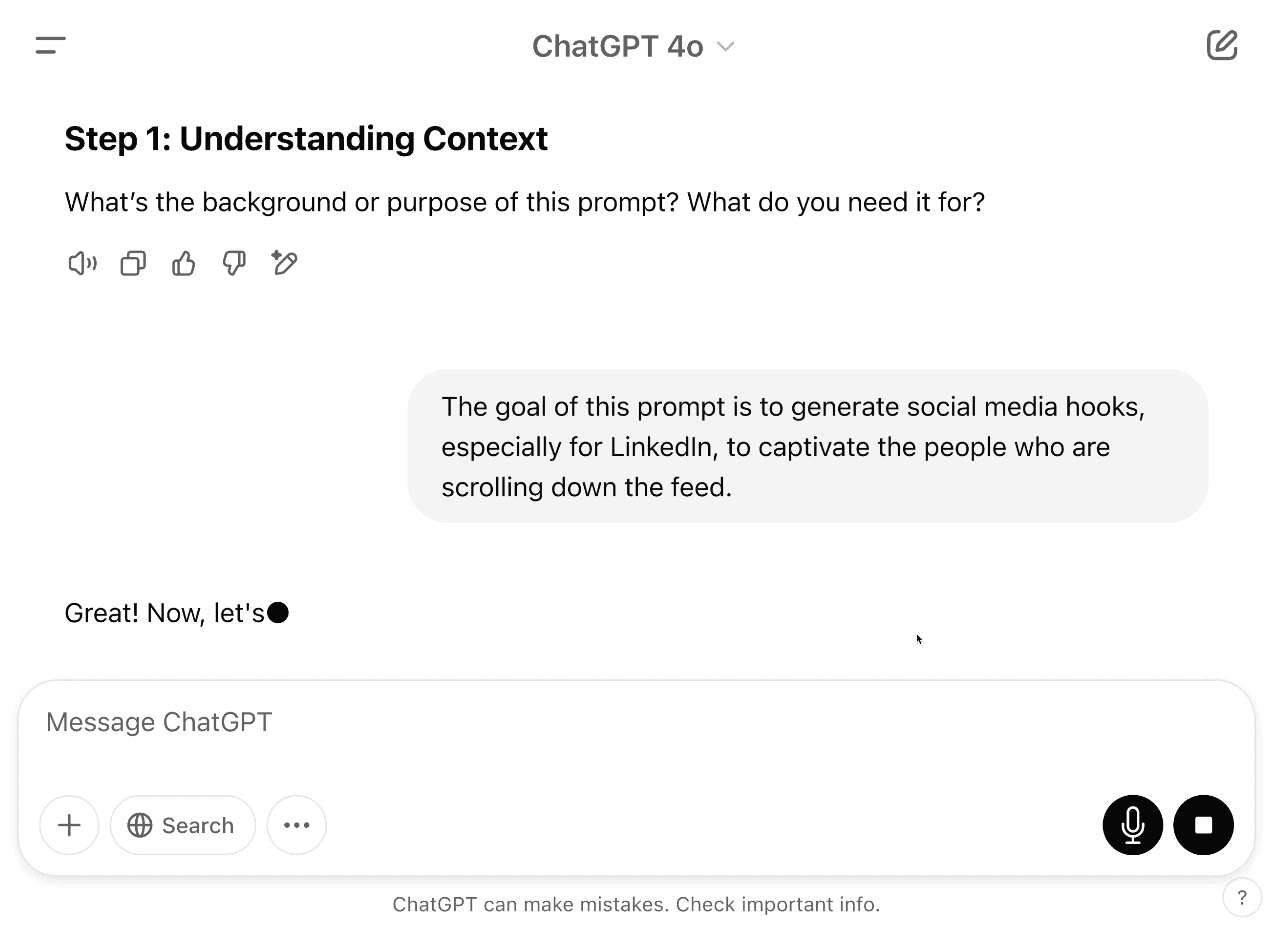
First, it asks about my background and purpose – trying to understand what kind of prompt I need.
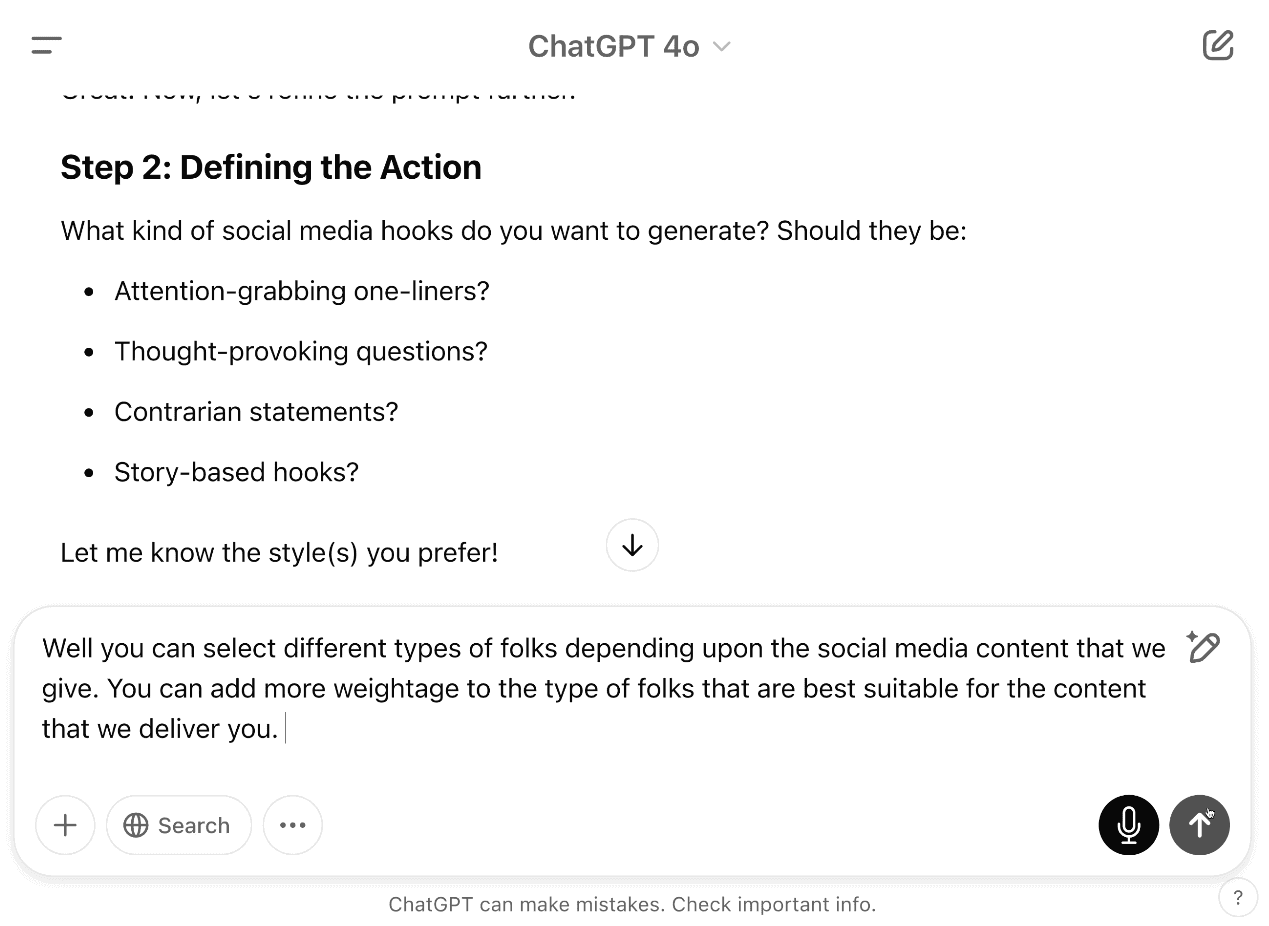
Then it digs deeper to understand what kind of hooks I want.
Does it need to grab attention? Tell stories? Create curiosity?
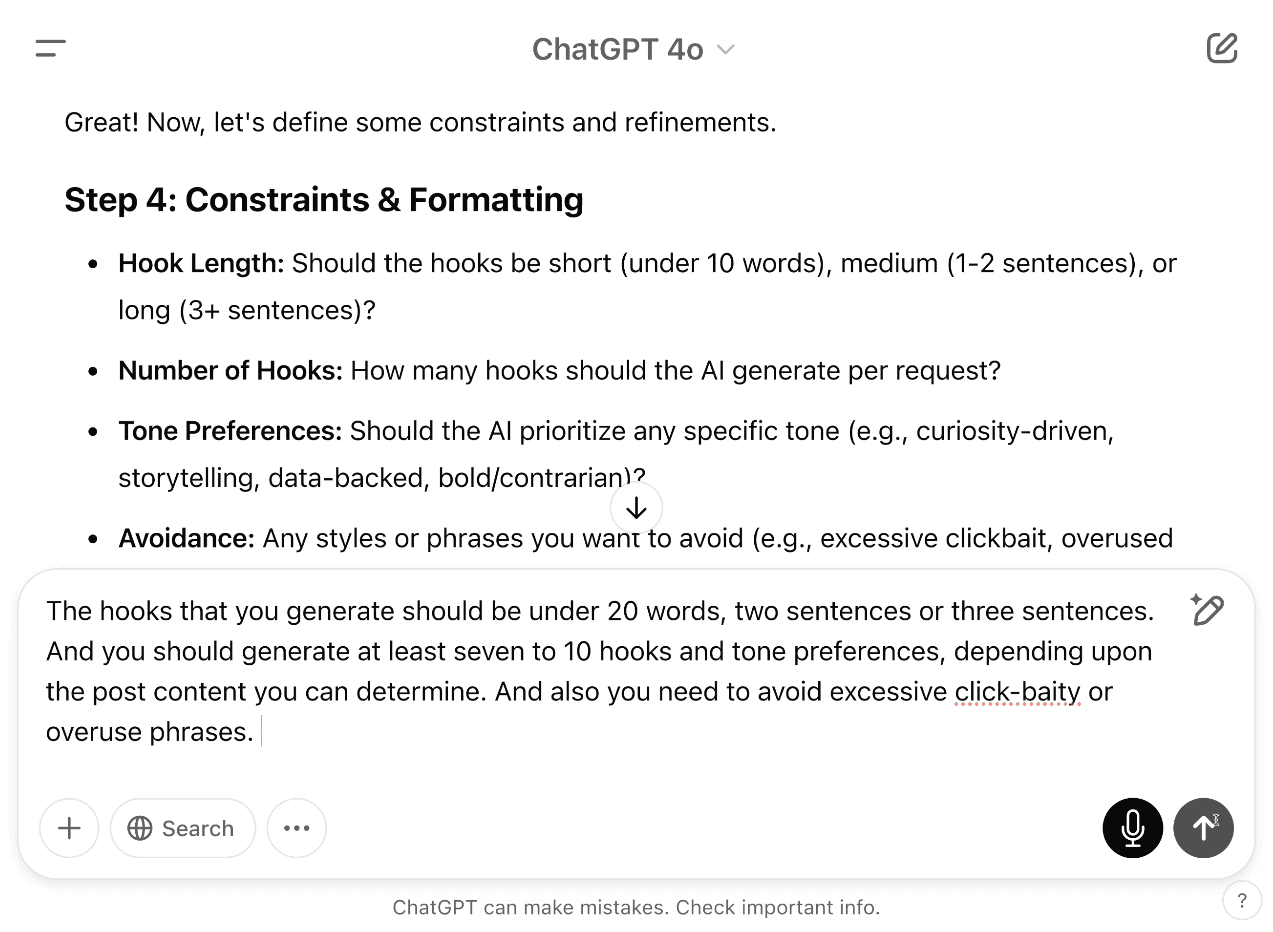
Next, it asks for all the key details needed for creating hooks that will make my LinkedIn posts stand out from the crowd.

Within minutes, I get a high-quality, custom-built prompt that fits my exact needs.
No confusion. No complexity.
Start with workflow, not prompts
Here’s what most people miss:
Even with this simple technique, you need clarity about your goals.
And for that clarity, start with your workflow.
Before jumping into AI writing, ask yourself – “What different roles do I handle in my business?“
In my case, it’s blogging, YouTube content, newsletter creation, and coaching.
Each role follows a set process.
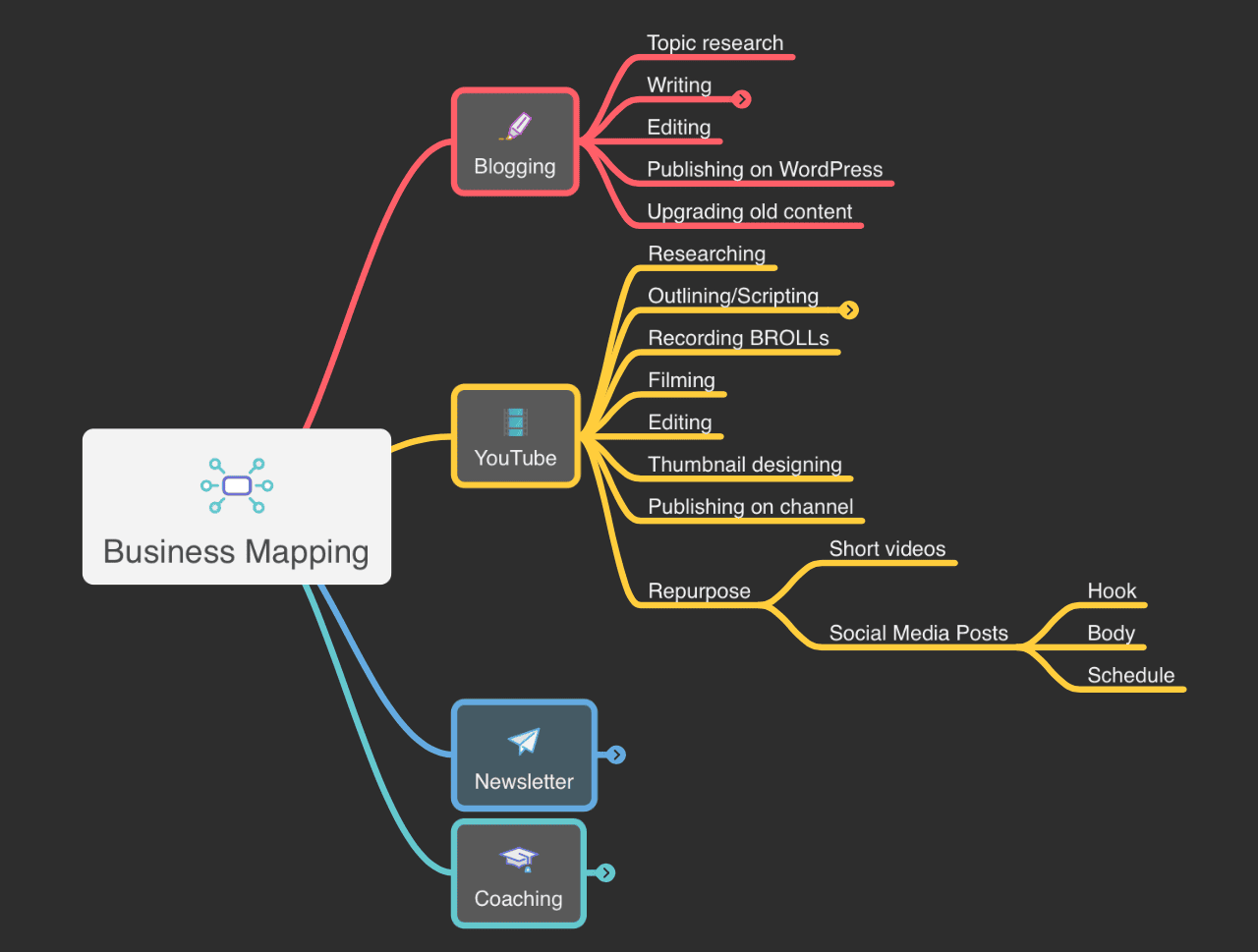
My blogging process has four main steps: thorough topic research, writing the first draft, improving the content, and publishing on WordPress.
For YouTube videos, I follow these steps: research, content outline, video recording, editing, and sharing across platforms.
For LinkedIn posts, I use a simple system: craft an attention-grabbing hook, write the main content, format it properly, and schedule it.
👉 Once you map out this workflow, you’ll easily spot where AI can help, link different prompts together, and build systems that grow with you.
This organised approach means you’re using AI with purpose, not randomly trying things out.
How I create content for LinkedIn using this system
Let’s look at a real example: writing hooks for LinkedIn posts.
Hooks are those first 1-2 lines that make people stop scrolling.
They grab attention and make readers curious.
You can use different types of hooks – bold statements, questions, emotional triggers, or relatable stories that connect with your audience.
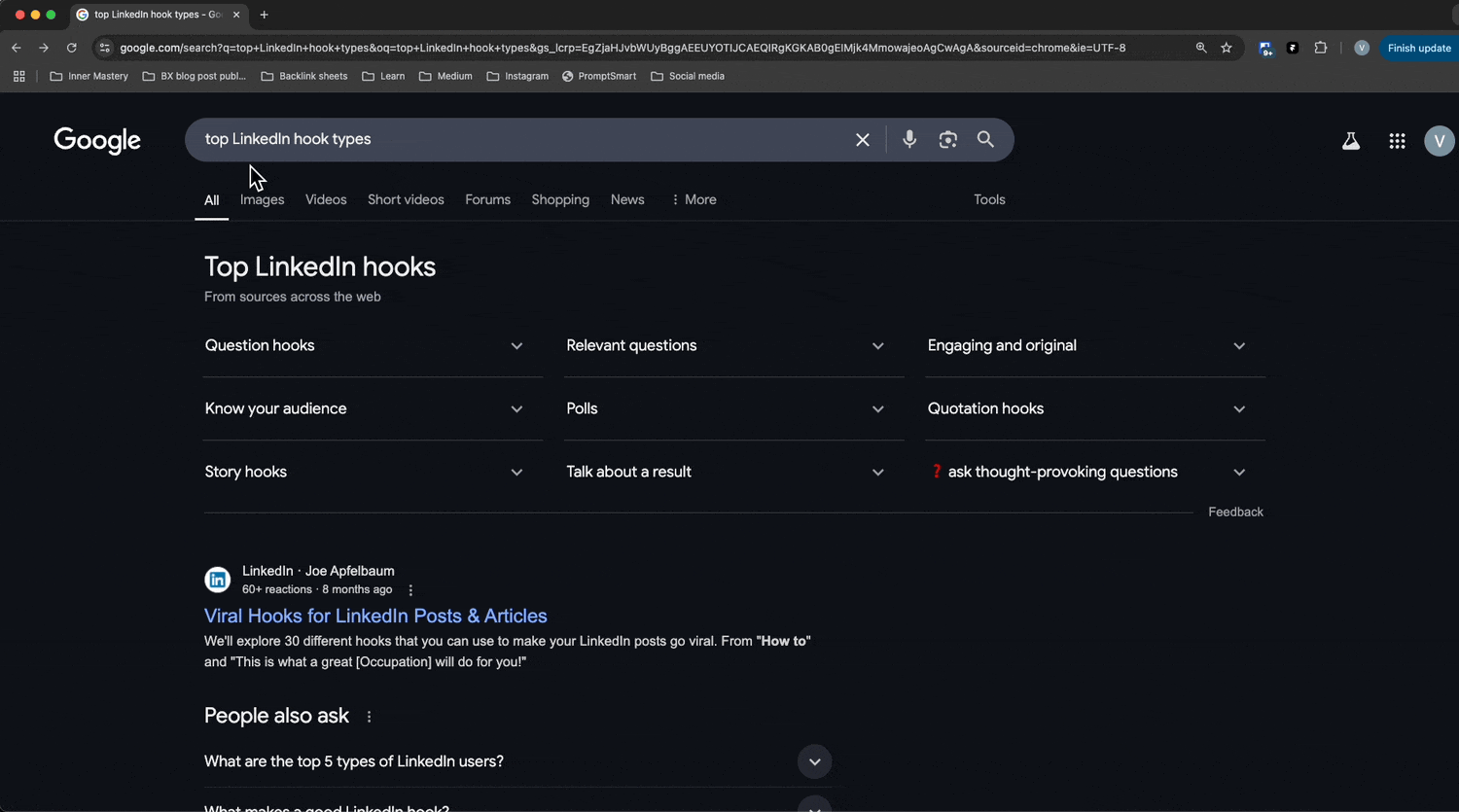
Forget googling “top LinkedIn hook types” and testing them yourself.
Reverse prompting gives you something much better.
I simply used that meta prompt I mentioned earlier and told ChatGPT – “I want to generate LinkedIn social media hooks based on a specific topic“.
It then asked me a few basic questions – who my audience is, what I’m writing about, and what style I prefer.
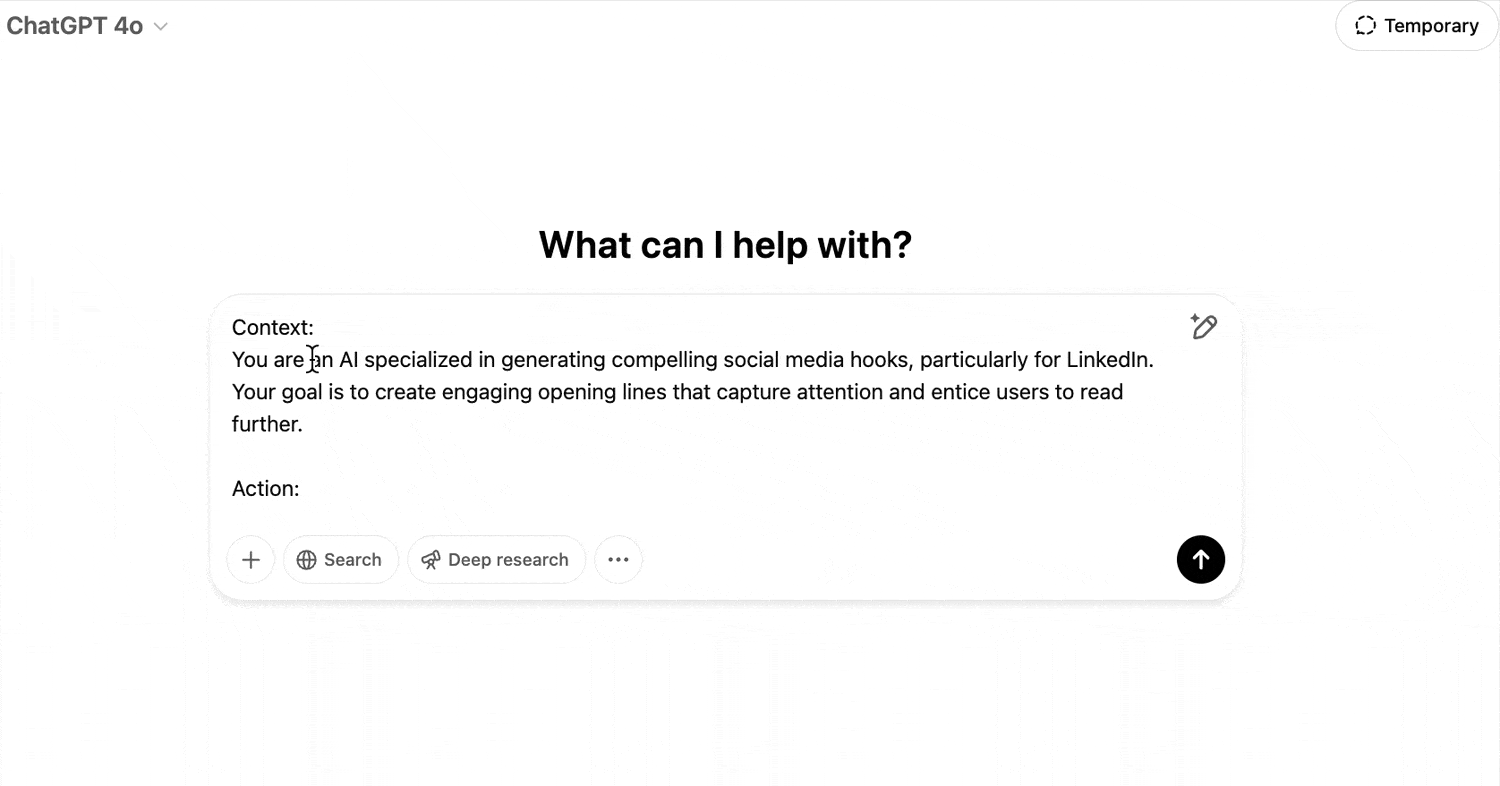
After sharing these details, it gave me some really solid, engaging hooks for my LinkedIn post.
Feeding knowledge into AI
Here’s a simple trick most people miss.
Your output quality depends on what you feed into the AI – even when using fancy techniques like prompt chaining or reverse prompting.
Let me share a quick example.
I came across this great post about the psychology of LinkedIn hooks.
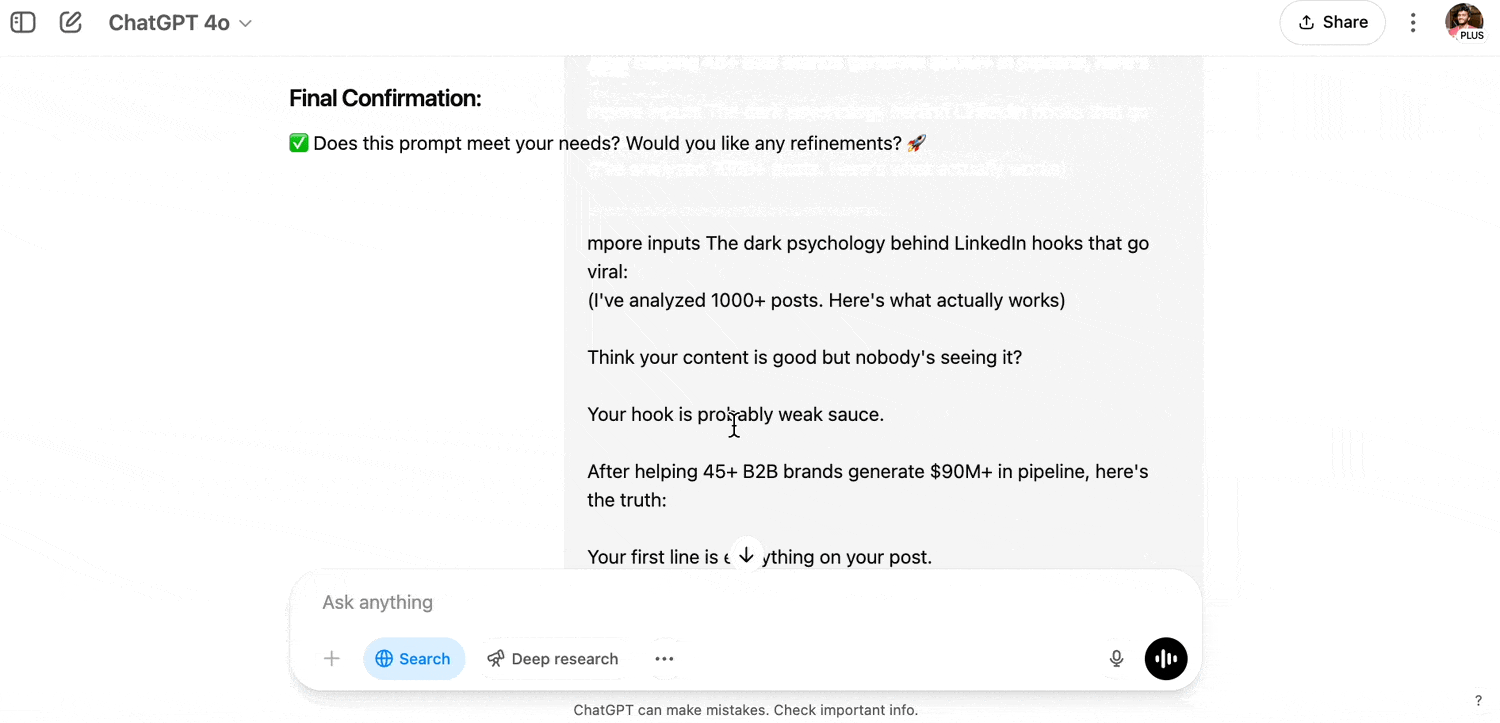
Instead of just reading and moving on, I did something different – I shared this post with ChatGPT.
Then I simply asked it to “Make my LinkedIn hook prompt better using what’s in this article“.
What happened next?
I got a much better prompt.
My hooks became more persuasive.
People engaged more with my content.
Want to know the best part?
I do this regularly using my LifeOS.
It’s simple – I use Notion as my personal knowledge bank.
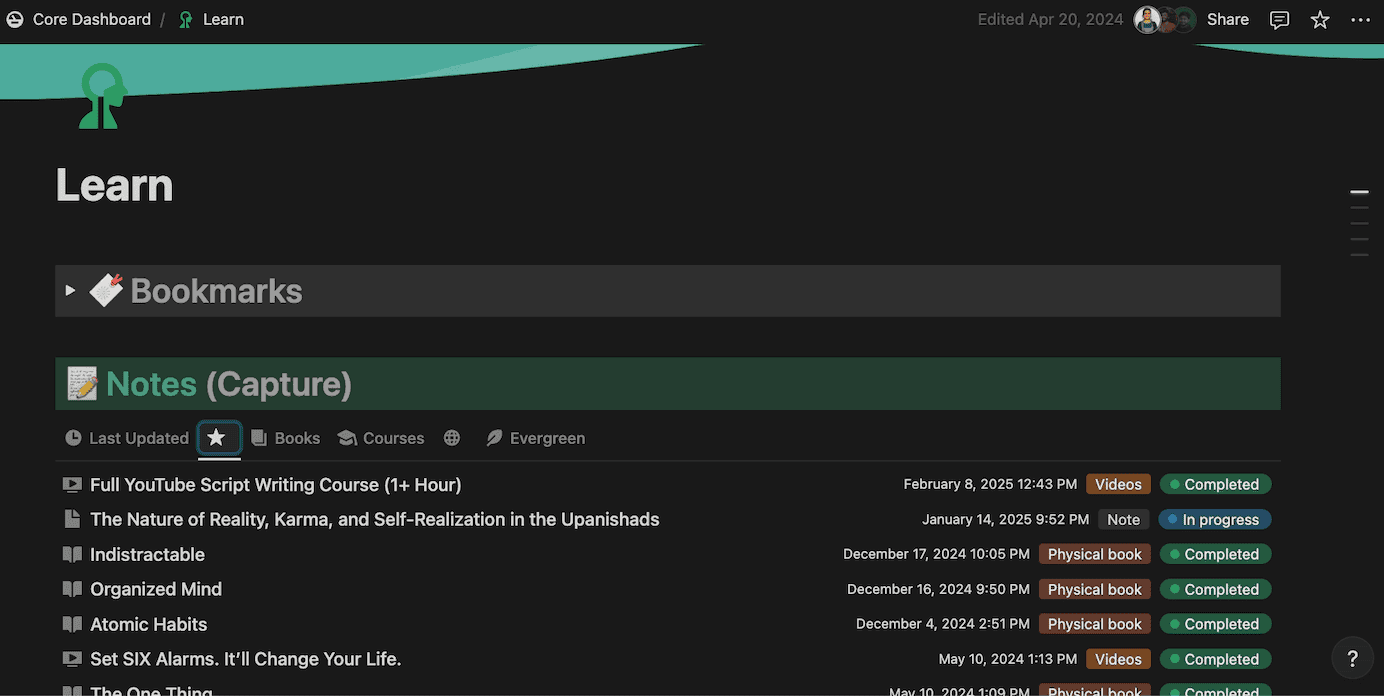
I save every piece of knowledge I come across – all my books, podcasts, and courses.
I save them all in Notion.

When I’m working on a video script, I simply pull up my notes – like the detailed lessons from Bryan’s YouTube strategy sessions.
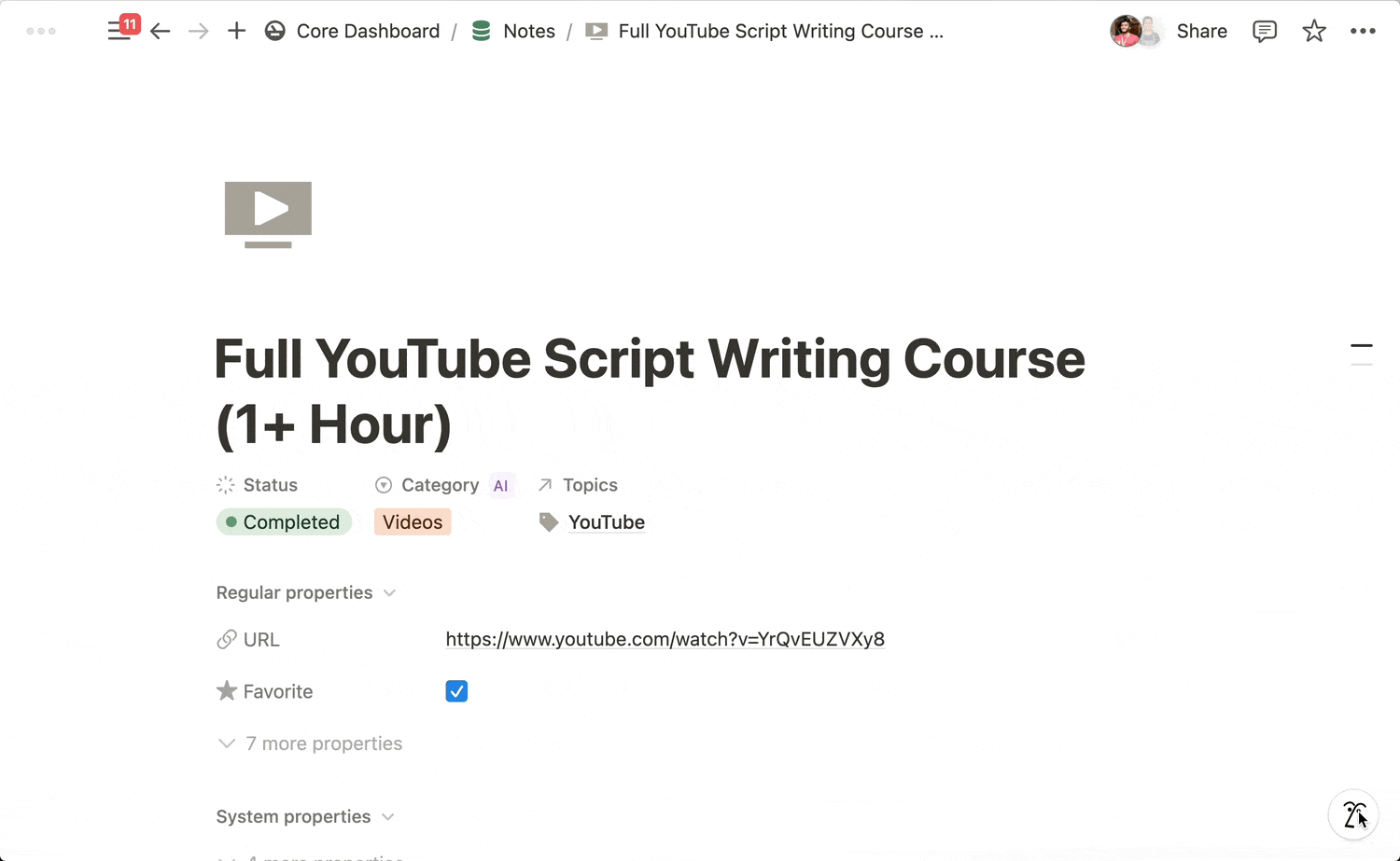
Then I feed all that context into Notion AI or ChatGPT.
This creates better prompts that tap into my actual knowledge and experience.
The result?
Much more useful outputs.
At this point, AI isn’t just another tool.
It becomes a natural extension of how you think.
What to do next (and why most won’t follow through)
Most people fail because they miss the basics.
They’re too busy chasing quick fixes.
But real success comes when you stop thinking about random prompts and start building proper workflows.
3 simple steps to build your own content creation system
- Map your content workflow – Before diving into AI prompts, identify each step of your content creation process. Break down exactly how you move from idea to published piece – just like I showed with my blogging, YouTube, and social media workflows.
- Create your meta prompts library – Use the reverse prompting technique to build custom prompts for each part of your workflow. Start with the meta prompt I shared and create specialized versions for different content types like blog structures, YouTube research, or headline generation.
- Build your knowledge management system – Start collecting and organizing your knowledge using Notion templates for content creators. This will help you feed better information into your AI prompts and produce higher quality content that stands out from basic AI-generated material.
👉 Want to see how this process works in more depth? I’ve created a complete guide to systematizing your online business that breaks down exactly how to build these workflows step by step.
Conclusion
AI isn’t replacing good content creators – it’s giving them superpowers.
The key difference between mediocre and exceptional results comes down to how you use these tools.
Most people will continue using basic prompts and getting basic results.
But by using reverse prompting to build powerful custom instructions, organizing your knowledge with Notion, and creating systematic workflows, you can produce content that stands out – even in today’s AI-saturated landscape.
My $2,000/month content team has been replaced with something more valuable: a system that helps me work smarter, faster, and more effectively.
And the best part?
You can build this same system for yourself.







